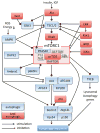Nutrient-sensing mTORC1: Integration of metabolic and autophagic signals
- PMID: 26773603
- PMCID: PMC4909545
- DOI: 10.1016/j.yjmcc.2016.01.005
Nutrient-sensing mTORC1: Integration of metabolic and autophagic signals
Abstract
The ability of adult cardiomyocytes to regenerate is limited, and irreversible loss by cell death plays a crucial role in heart diseases. Autophagy is an evolutionarily conserved cellular catabolic process through which long-lived proteins and damaged organelles are targeted for lysosomal degradation. Autophagy is important in cardiac homeostasis and can serve as a protective mechanism by providing an energy source, especially in the face of sustained starvation. Cellular metabolism is closely associated with cell survival, and recent evidence suggests that metabolic and autophagic signaling pathways exhibit a high degree of crosstalk and are functionally interdependent. In this review, we discuss recent progress in our understanding of regulation of autophagy and its crosstalk with metabolic signaling, with a focus on the nutrient-sensing mTOR complex 1 (mTORC1) pathway.
Keywords: Amino acids; Autophagy; Glucose; Hypoxia; Metabolism; mTORC1.
Copyright © 2016 Elsevier Ltd. All rights reserved.
Figures
Similar articles
-
Inflammasome, mTORC1 activation, and metabolic derangement contribute to the susceptibility of diabetics to infections.Med Hypotheses. 2015 Dec;85(6):997-1001. doi: 10.1016/j.mehy.2015.08.019. Epub 2015 Sep 6. Med Hypotheses. 2015. PMID: 26384528
-
Autophagy regulation by nutrient signaling.Cell Res. 2014 Jan;24(1):42-57. doi: 10.1038/cr.2013.166. Epub 2013 Dec 17. Cell Res. 2014. PMID: 24343578 Free PMC article. Review.
-
mTOR and autophagy: a dynamic relationship governed by nutrients and energy.Semin Cell Dev Biol. 2014 Dec;36:121-9. doi: 10.1016/j.semcdb.2014.08.006. Epub 2014 Aug 23. Semin Cell Dev Biol. 2014. PMID: 25158238 Review.
-
Cellular adaptation to nutrient deprivation: crosstalk between the mTORC1 and eIF2α signaling pathways and implications for autophagy.Cell Cycle. 2015;14(16):2571-7. doi: 10.1080/15384101.2015.1056947. Cell Cycle. 2015. PMID: 26039820 Free PMC article.
-
The lysosome: a crucial hub for AMPK and mTORC1 signalling.Biochem J. 2017 Apr 13;474(9):1453-1466. doi: 10.1042/BCJ20160780. Biochem J. 2017. PMID: 28408430 Review.
Cited by
-
Amino acid homeostasis and signalling in mammalian cells and organisms.Biochem J. 2017 May 25;474(12):1935-1963. doi: 10.1042/BCJ20160822. Biochem J. 2017. PMID: 28546457 Free PMC article. Review.
-
Starvation Promotes Autophagy-Associated Maturation of the Ovary in the Giant Freshwater Prawn, Macrobrachium rosenbergii.Front Physiol. 2017 May 12;8:300. doi: 10.3389/fphys.2017.00300. eCollection 2017. Front Physiol. 2017. PMID: 28553234 Free PMC article.
-
Autophagy: a necessary evil in cancer and inflammation.3 Biotech. 2024 Mar;14(3):87. doi: 10.1007/s13205-023-03864-w. Epub 2024 Feb 20. 3 Biotech. 2024. PMID: 38390576 Free PMC article. Review.
-
TM9SF4 is a novel factor promoting autophagic flux under amino acid starvation.Cell Death Differ. 2018 Feb;25(2):368-379. doi: 10.1038/cdd.2017.166. Epub 2017 Nov 10. Cell Death Differ. 2018. PMID: 29125601 Free PMC article.
-
Is targeting autophagy mechanism in cancer a good approach? The possible double-edge sword effect.Cell Biosci. 2021 Mar 20;11(1):56. doi: 10.1186/s13578-021-00570-z. Cell Biosci. 2021. PMID: 33743781 Free PMC article. Review.
References
-
- Stanley WC, Recchia FA, Lopaschuk GD. Myocardial substrate metabolism in the normal and failing heart. Physiol Rev. 2005 Jul;85(3):1093–129. - PubMed
-
- Whelan RS, Kaplinskiy V, Kitsis RN. Cell death in the pathogenesis of heart disease: mechanisms and significance. Annu Rev Physiol. 2010;72:19–44. - PubMed
-
- Jennings RB. Historical perspective on the pathology of myocardial ischemia/reperfusion injury. Circ Res. 2013 Aug 2;113(4):428–38. - PubMed
Publication types
MeSH terms
Substances
Grants and funding
LinkOut - more resources
Full Text Sources
Other Literature Sources
Miscellaneous





